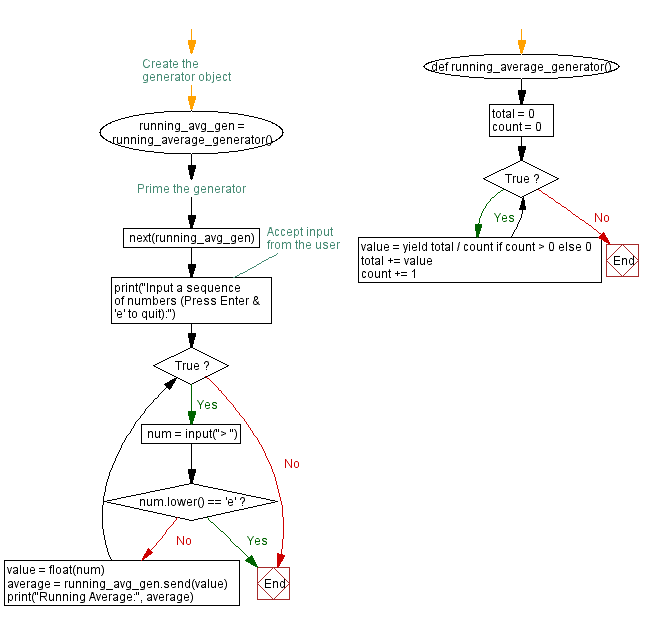Python Running Average Generator: Calculate the average of a sequence
16. Running Average Generator
Write a Python program to implement a generator function that generates the running average of a sequence of numbers.
Sample Solution:
Python Code:
def running_average_generator():
total = 0
count = 0
while True:
value = yield total / count if count > 0 else 0
total += value
count += 1
# Create the generator object
running_avg_gen = running_average_generator()
# Prime the generator
next(running_avg_gen)
# Accept input from the user
print("Input a sequence of numbers (Press Enter & 'e' to quit):")
while True:
num = input("> ")
if num.lower() == 'e':
break
value = float(num)
average = running_avg_gen.send(value)
print("Running Average:", average)
Sample Output:
Input a sequence of numbers (Press Enter & 'e' to quit): > 5 Running Average: 5.0 > 6 Running Average: 5.5 > 7 Running Average: 6.0 > e
Input a sequence of numbers (Press Enter & 'e' to quit): > -1 Running Average: -1.0 > -2 Running Average: -1.5 > -3 Running Average: -2.0 > -4 Running Average: -2.5 > e
Explanation:
In the above exercise,
The generator function running_average_generator() maintains a running total (total) and count (count) of the numbers received. It continuously yields the running average by dividing the total by the count (if count > 0) or 0 if count is 0.
We create the generator object running_avg_gen and prime it by calling next(running_avg_gen) before entering the input loop. We accept a sequence of numbers from the user until they enter 'e' to quit. Each number is sent to the generator using the send() method, and the running average is printed.
Flowchart:

For more Practice: Solve these Related Problems:
- Write a Python program to create a generator that yields the running average of numbers from a given list, printing each intermediate average.
- Write a Python function that computes the cumulative average of an iterable using a generator and then returns the final average.
- Write a Python script to generate the running average of user-provided numbers and then print all intermediate averages.
- Write a Python program to calculate the running average for a stream of data and verify the result by comparing it with the final average computed traditionally.
Go to:
Previous: Generate factors for a number.
Next: Generate the powers of a number.
Python Code Editor:
Contribute your code and comments through Disqus.
What is the difficulty level of this exercise?
Test your Programming skills with w3resource's quiz.
